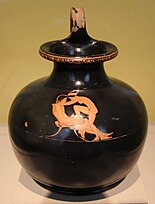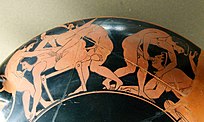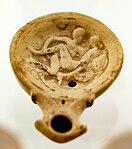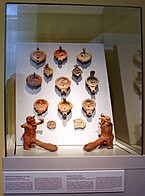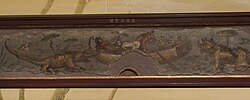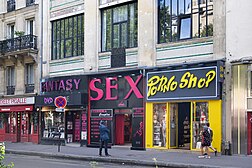
A | B | C | D | E | F | G | H | CH | I | J | K | L | M | N | O | P | Q | R | S | T | U | V | W | X | Y | Z | 0 | 1 | 2 | 3 | 4 | 5 | 6 | 7 | 8 | 9

Pornography (colloquially known as porn or porno) has been defined as sexual subject material "such as a picture, video, or text" that is intended for sexual arousal.[a] Made for the consumption by adults, pornography depictions have evolved from cave paintings, some forty millennia ago, to virtual reality presentations. A general distinction of adult content is made classifying it as pornography or erotica.
The oldest artifacts considered pornographic were discovered in Germany in 2008 CE and are dated to be at least 35,000 years old.[b] Throughout the history of erotic depictions, various people made attempts to suppress them under obscenity laws, censor, or make them illegal. Such grounds and even the definition of pornography have differed in various historical, cultural, and national contexts. The Indian Sanskrit text Kama Sutra (3rd century CE) contained prose, poetry, and illustrations regarding sexual behavior, and the book was celebrated; while the British English text Fanny Hill (1748), considered "the first original English prose pornography," has been one of the most prosecuted and banned books. In the late 19th century, a film by Thomas Edison that depicted a kiss was denounced as obscene in the United States, whereas Eugène Pirou's 1896 film Bedtime for the Bride was received very favorably in France. Starting from the mid-twentieth century on, societal attitudes towards sexuality became more lenient in the Western world where legal definitions of obscenity were made limited. In 1969, Blue Movie became the first film to depict unsimulated sex that received a wide theatrical release in the United States. This was followed by the "Golden Age of Porn" (1969–1984). The introduction of home video and the World Wide Web in the late 20th century led to global growth in the pornography business. Beginning in the 21st century, greater access to the Internet and affordable smartphones made pornography more mainstream.
Pornography has been vouched to provision a safe outlet for sexual desires that may not be satisfied within relationships and be a facilitator of sexual fulfillment in people who do not have a partner. It has been equated with journalism, as both offer a view into the unknown or the hidden aspects. Pornography use is considered a widespread recreational activity in-line with other digitally mediated activities such as use of social media or video games.[c] Motivations for pornography use may include fantasy, habitual use, mood management, or as part of a relationship. People who regard porn as sex education material were identified as more likely not to use condoms in their own sex life, thereby assuming a higher risk of contracting sexually transmitted infections (STIs); performers working for pornographic studios undergo regular testing for STIs unlike much of the general public. Comparative studies indicate higher tolerance and consumption of pornography among adults tends to be associated with their greater support for gender equality. Among feminist groups, some seek to abolish pornography believing it to be harmful, while others oppose censorship efforts insisting it is benign. A longitudinal study had ascertained that pornography use is not a predictive factor in intimate partner violence.[d] Porn Studies, which began in 2014, is the first international peer-reviewed, academic journal dedicated to critical study of "products and services" deemed pornographic.
Pornography is the major influencer of people's perception of sex in the digital age. Pornographic websites rank among the top 50 most visited websites worldwide. Called an "erotic engine", pornography has been noted for its key role in the development of various communication and media processing technologies. For being an early adopter of innovations and as a provider of financial capital, the pornography industry has been cited to be a contributing factor in the adoption and popularization of media related technologies. The accurate economic size of the porn industry in the early twenty-first century is unknown. In 2015, estimates of the worldwide market value stood at US$97 billion, with the US revenue valued at $10 to $12 billion. The US revenue was estimated to have reached at least US$3.3 billion in 2020. Pornography in Japan was estimated to be worth over $20 billion in 2018. The US pornography industry employs numerous performers along with production and support staff, and has its own industry-specific publications: XBIZ and AVN; a trade association, the Free Speech Coalition; a labor union, Adult Performer Advocacy Committee; and award shows, XBIZ Awards and AVN Awards. From the mid-2010s, unscrupulous pornography such as deepfake pornography and revenge porn have become issues of concern.
Etymology and definition
The word pornography is a conglomerate of two ancient Greek words: πόρνος (pórnos) "fornicators", and γράφειν (gráphein) "writing, recording, or description".[1] In Greek language, the term pornography connotes depiction of sexual activity;[2] no date is known for the first use of the term pornography, the earliest attested, most related word found is πορνογράφος (pornographos) i.e. "someone writing about harlots" in the 3rd century CE work Deipnosophists by Athenaeus.[3][4]
The oldest published reference to the word pornography as in 'new pornographie,' is dated back to 1638 and is credited to Nathaniel Butter in a history of the Fleet newspaper industry.[5] The modern word pornography entered the English language as the more familiar word in 1842 via French "pornographie," from Greek "pornographos".[6]
The term porn is an abbreviation of pornography.[2] The related term πόρνη (pórnē) "prostitute" in Greek, originally meant "bought, purchased" similar to pernanai "to sell", from the proto-Indo-European root per-, "to hand over" — alluding to act of selling.[2]
The word pornography was originally used by classical scholars as "a bookish, and therefore inoffensive term for writing about prostitutes",[7] but its meaning was quickly expanded to include all forms of "objectionable or obscene material in art and literature".[7] In 1864, Webster's Dictionary published "a licentious painting" as the meaning for pornography,[7] and the Oxford English Dictionary: "obscene painting" (1842), "description of obscene matters, obscene publication" (1977 or earlier).[8]
Definitions for the term "pornography" are varied, with people from both pro- and anti-pornography groups defining it either favorably or unfavorably, thus making any definition very stipulative.[9][10][11] Nevertheless, academic researchers have defined pornography as sexual subject material "such as a picture, video, or text" that is primarily intended to assist sexual arousal in the consumer, and is created and commercialized with "the consent of all persons involved".[a] Arousal is considered the primary objective, the raison d'etre a material must fulfill for it to be treated as pornographic.[14] As some people can feel aroused by an image that is not meant for sexual arousal and conversely cannot feel aroused by material that is clearly intended for arousal, the material that can be considered as pornography becomes subjective.[14]
Pornography throughout history
Pornography from ancient times
As the very definition of pornography is subjective, a specified history of pornography is inconceivable.[15] Pornography is viewed by historians as a complex cultural formation.[16] Depictions of a sexual nature existed since prehistoric times as seen in Venus figurines and rock art.[17] People across various civilizations have created works that depicted explicit sex; these include artifacts, music, poetry, and murals among other things that are often intertwined with religious and supernatural themes.[18] The oldest artifacts, including the Venus of Hohle Fels, which are considered to be pornographic were discovered in 2008 CE at a cave near Stuttgart in Germany, radiocarbon dating suggests they are at least 35,000 years old, belonging to the Aurignacian period.[b]
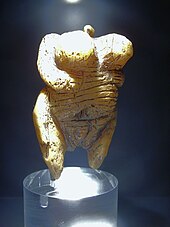
Vast number of artifacts that have been discovered in ancient Mesopotamia had explicit depictions of heterosexual sex.[20][21] Glyptic art from the Sumerian Early Dynastic Period frequently shows scenes of frontal sex in the missionary position.[20] In Mesopotamian votive plaques, from the early second millennium BCE, a man is usually shown penetrating a woman from behind while she bends over drinking beer through a straw.[20] Middle Assyrian lead votive figurines often represented a man standing and penetrating a woman as she rests on an altar.[20]
Scholars have traditionally interpreted all these depictions as scenes of hieros gamos (an ancient sacred marriage between a god and a goddess), but they are more likely to be associated with the cult of Inanna, the Mesopotamian goddess of sex and sacred prostitution.[20] Many sexually explicit images, including models of male and female sexual organs, were found in the temple of Inanna at Assur.[20]
Depictions of sexual intercourse were not part of the general repertory of ancient Egyptian formal art, but rudimentary sketches of heterosexual intercourse have been found on pottery fragments and in graffiti.[22] The final two thirds of the Turin Erotic Papyrus (Papyrus 55001), an Egyptian papyrus scroll discovered at Deir el-Medina,[22] consists of a series of twelve vignettes showing men and women in various sexual positions. The scroll was probably painted in the Ramesside period (1292–1075 BCE) and its high artistic quality indicates that it was produced for a wealthy audience. No other similar scrolls have yet been discovered.[22]
Archaeologist Nikolaos Stampolidis had noted that the society of ancient Greece held lenient attitudes towards sexual representation in the fields of art and literature.[23] The Greek poet Sappho's Ode to Aphrodite (600 BCE) is considered an earliest example of lesbian poetry.[18] Red-figure pottery invented in Greece (530 BCE) often portrayed images that displayed eroticism.[24] The fifth-century BC comic Aristophanes elaborated 106 ways of describing the male genitalia and in 91 ways the female genitalia.[23] Lysistrata (411 BCE) is a sex-war comedy play performed in ancient Greece.[25]
In India, Hinduism embraced an inquisitive attitude towards sex as an art and a spiritual ideal.[26] Some ancient Hindu temples incorporated various aspects of sexuality into their art work. The temples at Khajuraho and Konark are particularly renowned for their sculptures, which had detailed representations of human sexual activity.[27] These depictions were viewed with a spiritual outlook as sexual arousal is believed to indicate the embodying of the divine.[e][31]

"pornography is sometimes characterised as the symptom of a degenerate society, but anyone even noddingly familiar with Greek vases or statues on ancient Hindu temples will know that so-called unnatural sex acts, orgies and all manner of complex liaisons have for millennia past been represented in art for the pleasure and inspiration of the viewer everywhere. The desire to ponder images of love-making is clearly innate in the human – perhaps particularly the male – psyche." — Tom Hodgkinson[32]
Kama, the word used to connote sexual desire, was explored in Indian literary works such as the Kama Sutra, which dealt with the practical as well as the psychological aspects of human courtship and sexual intercourse.[33][34] The Sanskrit text Kama sutra was compiled by the sage Vatsyayana into its final form sometime during the second half of the third century CE.[35] This text, which included prose, poetry, as well as illustrations regarding erotic love and sexual behavior,[18] is one of the most celebrated Indian erotic works.[36]
Koka shastra is another medieval Indian work that explored kama.[27] Other examples of early art and literature of sexual nature include: Ars Amatoria (Art of Love), a second-century CE treatise on the art of seduction and sensuality by the Roman poet Ovid;[15] the artifacts of the Moche people in Peru (100 CE to 800 CE);[18] The Decameron, a collection of short stories, some of which are sexual in nature by the 14th-century Italian author Giovanni Boccaccio;[15] and the fifteenth-century Arabic sex manual The Perfumed Garden.[18]
Pornography from early modern era
A highly developed culture of visual erotica flourished in Japan during the early modern era. From at least the 17th century, erotic artworks became part of the mainstream social culture.[15] Depictions of sexual intercourse were often presented on pictures that were meant to provide sex education for medical professionals, courtesans, and married couples. Makura-e (pillow pictures) were made for entertainment as well as for the guidance of married couples.[15] The ninth-century Japanese art form "Shunga" that depicted sexual acts on woodblock prints and paintings became so popular by the 18th century that the Japanese government began to issue official edicts against them. Even so, Japanese erotica flourished with the works of artists such as Suzuki Harunobu achieving worldwide fame.[18][15] Japanese censorship laws enacted in 1870 made the production of erotic works difficult. The laws remained in effect until the end of the Pacific War in 1945; nevertheless, pornography flourished through the sale of "erotic, grotesque, nonsense" (ero-guro-nansensu) periodicals, particularly in the Taishō era (1912–1926).[37] From the 1960s, pink films, which portrayed sexual themes became popular in Japan. In 1981 the first Japanese Adult video (AV) was released.[38] The Japanese pornography industry peaked in the early 2000s when about 30,000 AVs were made a year. From the mid-2010s, increased availability of free porn on the Internet led to a decline in the production of AVs.[38] Other forms of adult entertainment such as hentai, which refers to pornographic manga and anime, and erotic video games have become popular in recent decades.[38]

In Europe, the Italian Renaissance work from the 16th century - I Modi (The Ways) also known as The Sixteen Pleasures became famous for its engravings that explicitly depicted sex positions.[39] The publication of this book was considered the beginning of print pornography in Rome.[40] The second edition of this book was published in 1527, titled Aretino Postures, which combined erotic images with text - a first in the Western culture.[40] The Vatican called for the complete destruction of all the copies of the book and imprisonment of its author Marcantonio Raimondi.[40] With the development of printing press in Europe, the publication of written and visual material, which was essentially pornographic began. Heptaméron written in French by Marguerite de Navarre and published posthumously in 1558 is one of the earliest examples of salacious texts from this era.[15] Beginning with the Age of Enlightenment and advances in printing technology, the production of erotic material became popular enough that an underground marketplace for such works developed in England with a separate publishing and bookselling business.[15] Historians have identified the 18th century as an age of pornographic opulence.[41] Written by anonymous authors, the titles: The Progress of Nature (1744); The History of the Human Heart: or, the Adventures of a Young Gentleman (1749), which had descriptions of female ejaculation; and The Child of Nature (1774) have been noted as prominent pornographic fictional works from this period.[42] The book Fanny Hill (1748), is considered "the first original English prose pornography, and the first pornography to use the form of the novel."[43] An erotic literary work by John Cleland, Fanny Hill was first published in England as Memoirs of a Woman of Pleasure.[44][45] The novel has been one of the most prosecuted and banned books in history.[46][47] The author John Cleland was charged for "corrupting the King's subjects."[48]
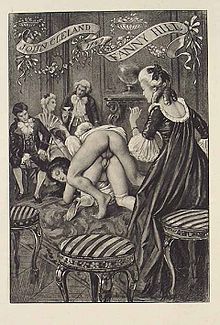
At around the same time, erotic graphic art that began to be extensively produced in Paris came to be known in the Anglosphere as "French postcards".[15] Enlightenment-era France had been noted by historians as the center of origin for modern-era pornography.[49] The works of French pornography, which often concentrated on the education of an ingénue into libertine, dominated the sale of sexually explicit content.[50] The French sought to interlace narratives of sexual pleasure with philosophical and anti-establishment basis.[50] Political pornography began with the French Revolution (1789–99).[51] Apart from the sexual component, pornography became a popular medium for protest against the social and political norms of the time.[15] Pornography during this period was used to explore the ideas of sexual freedom for women and men, the various methods of contraception, and to expose the offenses of powerful royals and elites.[15] The working and lower classes in France produced pornographic material en masse with themes of impotency, incest, and orgies that ridiculed the authority of the Church-State, aristocrats, priests, monks, and other royalty.[51] One of the most important authors of socially radical pornography was the French aristocrat Marquis de Sade (1740–1814), whose name helped derive the words "sadism" and "sadist". He advocated libertine sexuality and published writings that were critical of authorities, many of which contained pornographic content.[52] His work Justine (1791) interlaced orgiastic scenes along with extensive debates on the ills of property and traditional hierarchy in society.[15]
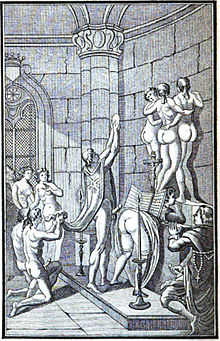
When large-scale archaeological excavations were undertaken in the ancient Roman city of Pompeii during the 18th century, much of the erotic art in Pompeii and Herculaneum came to light, shocking the authorities who endeavored to hide them away from the general public. In 1821, the moveable objects were locked away in the Secret Museum in Naples, and what could not be removed was either covered or cordoned off from public view.[53]
During the Victorian era (1837–1901), the invention of the rotary printing press made publication of books easier, many works of lascivious nature were published during this period often under pen names or anonymity.[55] In 1837, the Holywell Street (known as "Booksellers' Row") in London had more than 50 shops that sold pornographic material.[15] Many of the works published in the Victorian era are considered bold and graphic even by today's lenient standards.[56] The English novel The Adventures, Intrigues, and Amours, of a Lady's Maid! written by anonymous "Herself" (c. 1838) professed the notion that homosexual acts are more pleasurable for women than heterosexuality which is linked to painful and uncomfortable experiences.[57] Some of the popular publications from this era include: The Pearl (magazine of erotic tales and poems published from 1879 to 1881); Gamiani, or Two Nights of Excess (1870) by Alfred de Musset; and Venus in Furs (1870) by Leopold von Sacher-Masoch, from whose name the term "masochism" was derived.[55] The Sins of the Cities of the Plain (1881) is one of the first sole male homosexual literary work published in English, this work is said to have inspired another gay literary work Teleny, or The Reverse of the Medal (1893), whose authorship has often been attributed to Oscar Wilde.[56] The Romance of Lust, written anonymously and published in four volumes during 1873–1876, contained graphical descriptions of themes detailing incest, homosexuality, and orgies.[58] Other publications from the Victorian era that included fetish and taboo themes such as sadomasochism and 'cross-generational sex' are: My Secret Life (1888–1894) and Forbidden Fruit (1898). On accusations of obscenity many of these works had been outlawed until the 1960s.[58]
Criminalization
The English act
The world's first law that criminalized pornography was the English Obscene Publications Act 1857, enacted at the urging of the Society for the Suppression of Vice.[59][58] The act passed by the British Parliament in 1857 applied to the United Kingdom and Ireland. The act made the sale of obscene material a statutory offense, and gave the authorities the power to seize and destroy any material which they considered as obscene.[60][61]
For centuries before, sexually explicit material was considered a domain that is exclusive to aristocratic classes.[40] When pornographic material flourished in the Victorian-era England, the affluent classes believed they are sensible enough to deal with it, unlike the lower working classes whom they thought would get distracted by such material and cease to be productive. Beliefs that masturbation would make people ill, insane, or become blind also flourished.[58] The obscenity act gave government officials the power to interfere in the private lives of people unlike any other law before.[60] Some of the people suspected for masturbation were forced to wear chastity devices. "Cures" and "treatment" for masturbation involved such measures like giving electric shock and applying carbolic acid to the clitoris.[58] The law was criticized for being established on still yet unproven claims that sexual material is noxius for people or public health.[60]
The American act
In 1865, the US postal service was seen as a "vehicle" for the transmission of materials that were deemed obscene by the American lawmakers.[62] An act relating to the postal services was passed, which made people pay a fine of $500 for knowingly mailing any "obscene book, pamphlet, picture print, or other publication".[63] From 1865 to up until the first three months of 1872, a total number of nine people were held for various charges of obscenity, with one person sentenced to prison for a year; while in the next ten months fifteen people were arrested under this law. This was partly due to the efforts of Anthony Comstock, who became a major figure in 1872 and held great power to control sexual related activities of people including the choice of abortion.[64] The Comstock Act of 1873 is the American equivalent of the English Obscene Act.[65][66] The anti-obscenity bill, drafted by Anthony Comstock, was debated for less than an hour in the US Congress before being passed into law.[67] Apart from the power to seize and destroy any material alleged to be obscene, the law made it possible for the authorities to make arrests over any perceived act of obscenity, which included possession of contraceptives by married couples. Reportedly in the US, 15 tons of books and 4 million pictures were destroyed, and about 15 people were driven to suicide with 4,000 arrests.[67] At least 55 people whom Comstock identified as abortionists got indicted under the Comstock act.[68]
Steps towards liberalization
The laws regarding pornography have differed in various historical, cultural, and national contexts.[69] The English Act did not apply to Scotland where the common law continued to apply. Before the English Act, publication of obscene material was treated as a common law misdemeanor,[70] this made effectively prosecuting authors and publishers difficult even in cases where the material was clearly intended as pornography.[71] However, neither the English, nor the United States Act defined what constituted "obscene", leaving this for the courts to determine.[70] For implementing the Comstock act, the US courts used the British Hicklin test to define obscenity, the definition of which was first proposed in 1868, ten years after the passing of the English obscene act.[61] The definition became cemented in 1896 and continued until the mid-twentieth century. Starting from 1957 to 1997, the US Supreme Court made numerous judgments that redefined obscenity.[67][72]
The nineteenth-century legislation eventually outlawed the publication, retail and trafficking of certain writings and images that were deemed pornographic. Although laws ordered the destruction of shop and warehouse stock meant for sale, the private possession and viewing of (some forms of) pornography was not made an offense until the twentieth century.[71] Historians have explored the role of pornography in determining social norms.[73] The Victorian attitude that pornography was only for a select few is seen in the wording of the Hicklin test, stemming from a court case in 1868, where it asked: "whether the tendency of the matter charged as obscenity is to deprave and corrupt those whose minds are open to such immoral influences".[74]
Although officially prohibited, the sale of sexual material nevertheless continued through "under the counter" means. Magazines specialising in a genre called "saucy and spicy" became popular during this time (1896 to 1955), titles of few popular magazines include; Wink: A Whirl of Girls, Flirt: A FRESH Magazine, and Snappy. Cover stories in these magazines featured segments such as "perky pin-ups" and "high-heel cuties".[75] Some of the popular erotic literary works from the twentieth century include the novels: Story of the Eye (1928), Tropic of Cancer (1934), Tropic of Capricorn (1938), the French Histoire d'O (Story of O) (1954); and the short stories: Delta of Venus (1977), and Little Birds (1979).[76]
After the invention of photography, the birth of erotic photography followed. The oldest surviving image of a pornographic photo is dated back to about 1846, described as to depict "a rather solemn man gingerly inserting his penis into the vagina of an equally solemn and middle-aged woman".[75] At one point of time, it was more expensive to purchase an erotic photograph than to hire a prostitute.[77] The Parisian demimonde included Napoleon III's minister, Charles de Morny, an early patron who delighted in acquiring and displaying erotic photos at large gatherings.[78]
Pornographic film production commenced almost immediately after the invention of the motion picture in 1895. A pioneer of the motion picture camera, Thomas Edison, released various films, including The Kiss that were denounced as obscene in late 19th century America.[79][80] Two of the earliest pioneers of pornographic films were Eugène Pirou and Albert Kirchner. Kirchner directed the earliest surviving pornographic film for Pirou under the trade name "Léar". The 1896 film, Le Coucher de la Mariée, showed Louise Willy performing a striptease. Pirou's film inspired a genre of risqué French films that showed women disrobing, and other filmmakers realized profits could be made from such films.[81][82]
Legalization
Sexually explicit films opened producers and distributors to be liable for prosecution. Such films were produced illicitly by amateurs, starting in the 1920s, primarily in France and the United States. Processing the film was risky as was their distribution, which was strictly private.[83] In the Western world, during the 1960s, social attitudes towards sex and pornography slowly changed.[84] In 1967, Denmark repealed the obscenity laws on literature; this led to a decline in the sale of pornographic and erotic literature. Hoping for a similar effect, in the summer of 1969, legislators in Denmark abolished censorship on picture pornography,[85] thereby effectively becoming, from July 1, 1969, the first country that legalized pornography,[86][87] including child pornography, which was later prohibited in 1980.[88][89] The 1969 legislation, instead of resulting in a decline in pornography production, led to an explosion of investment in, and commercial production of pornography in Denmark, which made the country's name synonymous with sex and pornography.[85] The total retail turnover of pornography in Denmark for the year 1969 was estimated at $50 million. Much of the pornographic material produced in Denmark was smuggled into other countries around the world.[90]

In the United States, pornography is protected by the First Amendment to the United States Constitution unless it constitutes obscenity or child pornography that is produced with real children. Nevertheless, in Stanley v. Georgia (1969), the U.S. Supreme Court upheld the right of an adult to possess obscene material in private.[91] Subsequently, however, the Supreme Court rejected the claim that under Stanley there is a constitutional right to provide obscene material for private use[92] or to acquire it for private use.[93] The right to possess obscene material does not imply the right to provide or acquire it, because the right to possess it "reflects no more than ... the law's 'solicitude to protect the privacies of the life within '".[94]
In 1969, Blue Movie by Andy Warhol became the first feature film to depict explicit sexual intercourse that received a wide public theatrical release in the United States.[95][96]
Blue Movie was real. But it wasn't done as pornography—it was done as an exercise, an experiment. But I really do think movies should arouse you, should get you excited about people, should be prurient. Prurience is part of the machine. It keeps you happy. It keeps you running."
Film scholar Linda Williams remarked that prurience "is a key term in any discussion of moving-image sex since the sixties. Often it is the "interest" to which no one wants to own up".[98] In 1968, the Motion Picture Association of America created a new film ratings system in which any film that was not approved by the association was released with an "X" rating. When pornographers began to release their productions with the rating X, the association adopted NC-17 rating for adults only films, leaving the X rating to pornography. Later the invented gimmick rating "XXX" became a standard for pornographic material.[99]
Commissions and their findings
In 1970, the United States President's Commission on Obscenity and Pornography, set up to study the effects of pornography, reported that there was "no evidence to date that exposure to explicit sexual materials plays a significant role in the causation of delinquent or criminal behavior among youths or adults".[100] The report further recommended against placing any restriction on the access of pornography by adults and suggested that legislation "should not seek to interfere with the right of adults who wish to do so to read, obtain, or view explicit sexual materials".[101] Regarding the notion that sexually explicit content is improper, the Commission found it "inappropriate to adjust the level of adult communication to that considered suitable for children". The Supreme Court supported this view.[101]
In 1971, Sweden removed its obscenity clause. Further relaxation of legislations during the early 1970s in the US, West Germany and other countries led to rise in pornography production.[90] The 1970s had been described by Linda Williams as 'the "Classical" Era of Theatrically Exhibited Porn', a time period now called the Golden Age of Porn.[90][102]
In 1979, the British Committee on Obscenity and Film Censorship better known as the Williams Committee, formed to review the laws concerning obscenity reported that pornography could not be harmful and to think anything else is to see pornography "out of proportion". The committee declared that existing variety of laws in the field should be scrapped and so long as it is prohibited from children, adults should be free to consume pornography as they see fit.[103][104]
The Meese Report in 1986 argued against loosening restrictions on pornography in the US. The report was criticized as biased, inaccurate, and not credible.[105]
In 1988, the Supreme Court of California ruled in the People v. Freeman case that "filming sexual activity for sale" does not amount to procuring or prostitution and shall be given protection under the first amendment.[106] This ruling effectively legalized the production of X-rated adult content in the Los Angeles county, which by 2005 had emerged as the largest center in the world for the production of pornographic films.[106][107] Pornographic films appeared throughout the twentieth century. First as stag films (1900–1940s), then as porn loops or short films for peep shows (1960s), followed by as feature films for theatrical release in adult movie theaters (1970s), and as home videos (1980s).[108]
Role of magazines in legalization
Pornographic magazines published during the mid-twentieth century have been noted for playing an important role in the sexual revolution[109] and the liberalization of laws and attitudes towards sexual representation in the Western world.[110] Hugh Hefner, in 1953 published the first US issue of the Playboy, a magazine which as Hefner described is a "handbook for the urban male". The magazine contained images of nude women along with articles and interviews covering politics and culture.[76] Twelve years later, in 1965, Bob Guccione in the UK started his publication Penthouse, and published its first American issue in 1969 as a direct competitor to Playboy. In its early days, the images of naked women published in Playboy did not show any pubic hair or genitals. Penthouse became the first magazine to show pubic hair in 1970. Playboy followed the lead and there ensued a competition between the two magazines over publication of more racy pictures, a contest that eventually got labeled as the "Pubic Wars".[110]
"We were the first to show full frontal nudity. The first to expose the clitoris completely. I think we made a very serious contribution to the liberalization of laws and attitudes. HBO would not have gone as far as it does if it was not for us breaking the barriers. Much that has happened now in the Western world with respect to sexual advances is directly due to steps that we took." — Bob Guccione, Penthouse founder in 2004.[110]
The tussle between Playboy and Penthouse paled into obscurity when Larry Flynt started Hustler, which became the first magazine to publish labial "pink shots" in 1974. Hustler projected itself as the magazine for the working classes as opposed to the urban centered Playboy and Penthouse.[111] During the same time in 1972, Helen Gurley Brown, editor of the Cosmopolitan magazine, published a centerfold that featured actor Burt Reynolds in nude. His popular pose has been later emulated by many other famous people. The success of Cosmo led to the launch of Playgirl in 1973.[111] At their peak, Playboy sold close to six million copies a month in the US, while Penthouse nearly five million. In the 2010s, as the market for printed versions of pornographic magazines declined, with Playboy selling about a million and Penthouse about a hundred thousand, many magazines became online publications.[112] The best-selling US adult magazines maintain greater reach compared to most other non-pornographic magazines, and often rank among top-sellers.[113]
Modern-day pornography
Modern-day pornography began to take shape from the mid-1980s when the first desktop computers and public computer networks were released.[114] Since the 1990s, the Internet has made pornography more accessible and culturally visible.[115] Before the 90s, Usenet newsgroups served as the base for what has been called the "amateur revolution" where non-professionals from the late 1980s and early 1990s, with the help of digital cameras and the Internet, created and distributed their own pornographic content independent of mainstream networks.[116] The use of the World Wide Web became popular with the introduction of Netscape navigator in 1994. This development led to newer methods of pornography distribution and consumption.[117] The Internet turned out to be a popular source for pornography and was called the "Triple A-Engine" for offering consumers "anonymity, affordability, and accessibility", while driving the business of pornography.[114] The notion of Internet being a medium abound with porn became popular enough that in 1995 Time published a cover story titled "CYBERPORN" with the face of a shocked child as the cover photo.[118] In the Reno v. ACLU (1997) ruling, the US Supreme Court upheld the legality of pornography distribution and consumption by adults over the Internet. The Court noted that Government may not reduce the communication between adults to "only what is fit for children".[119][61]
With the introduction of broadband connections, much of the distribution networks of pornography moved online giving consumers anonymous access to a wide range of pornographic material.[115] To have better control over their content on the Internet some professional pornographers maintain their own websites.[114] Danni's Hard Drive started in 1995 by Danni Ashe is considered one of the earliest online pornographic websites, coded by Ashe – a former stripper and nude model, the website was reported by CNN to had generated revenues of $6.5 million by 2000.[120][117] According to some leading pornography providers on the Internet, customer subscription rates for a website would be about one in a thousand people who visit the site for a monthly fees averaging around $20.[121] Ashe said in an interview that her website employs 45 people and she expects to earn $8 million in 2001 alone.[122] The total number of pornographic websites in 2000 were estimated to be more than 60,000.[121] The development of streaming sites, peer-to-peer file sharing (P2P) networks, and tube sites led to a subsequent decline in the sale of DVDs and adult magazines.[115]
Starting in the 21st century, greater access to the Internet and affordable smartphones made pornography more accessible and culturally mainstream.[123][9][124] The total number of pornographic websites in 2012 was estimated to be around 25 million comprising 12% of all the websites.[120] About 75 percent of households in the US gained Internet access by 2012.[125] Data from 2015 suggests an increase in pornography consumption over the past few decades which is attributed to the growth of Internet pornography.[126] Technological advancements such as digital cameras, laptops, smartphones, and Wi-Fi have democratized the production and consumption of pornography.[116][127][128] Subscription-based service providers such as OnlyFans, founded in 2016, are becoming popular as the platforms for pornography trade in the digital era.[129][130] Apart from the professional pornographers, content creators on such platforms include others like;[129] a physics teacher,[131] a race car driver,[132] a woman undergoing cancer treatment.[133] In 2022, the total pornographic content accessible online was estimated to be over 10,000 terabytes.[134]
AVN and XBIZ are the industry-specific organizations based in the US that provide information about the adult entertainment business.[135] XBIZ Awards and AVN Awards, analogous to the Golden globes and Oscars, are the two prominent award shows of the adult entertainment industry.[136][137] Free Speech Coalition (FSC) is a trade association and Adult Performer Advocacy Committee (APAC) is a labor union for the adult entertainment industry based in the US.[138] The scholarly study of pornography notably in cultural studies is limited. Porn Studies, which began in 2014, is the first international peer-reviewed, academic journal that is exclusively dedicated to the critical study of the "products and services" identified to constitute pornography.[139]
Classification and commercialism
Adult content classifications
Adult content is generally classified as either pornography or erotica.[140] Considerations of distinctness between pornography and erotica is mostly subjective.[15] Pornographic content is categorized as softcore or hardcore.[114] Softcore pornography contains depictions of nudity but without explicit depiction of sexual activity.[114] Hardcore pornography includes explicit depiction of sexual activity.[141] Hardcore porn is more regulated than softcore porn.[141] Softcore porn was popular between the 1970s and 1990s.[142]
Mainstream pornography
Pornography productions cater to consumers of various sexual orientations.[143] Nonetheless, pornography featuring heterosexual acts made for heterosexual consumers, comprise the bulk of what is called the "mainstream porn", marking the industry more or less as "heteronormative".[143][144]
Mainstream pornography involves professional performers who work for various corporate film studios in their respective productions.[145]

Mainstream pornography productions are usually classified as feature or gonzo.[143][146] Features involve storylines, characterizations, scripted dialog, elegant costumes, detailed sets, and soundtracks, which make the productions look similar to mainstream Hollywood productions but with the depictions of explicit sexual activity included.[143][146][147] Features contain both original narratives as well as parodies that parody mainstream feature films, TV shows, celebrities, video games or literary works.[148][149][150] Gonzo is a form of content creation that attempts to put the viewer into the scene, this is commonly achieved by close-up camera work or performers talking to the audience; also called "wall-to-wall", gonzo involves some aspects of "breaking the fourth wall" between the audience and performers.[146][148] The term "gonzo" is often misused as a genre to identify demeaning depictions, however gonzo is a film-making style and not a genre.[148] Gonzo style is variably incorporated in the creation of all types or genres of adult content.[148] Gonzos do not involve the expensive sets or the costly production values of features, which makes their production relatively inexpensive.[147][148] From the mid-2010s about 95 percent of porn productions are gonzo.[128]
Indie pornography
Pornography productions that are independent of mainstream pornographic studios are classified as indie (or) independent pornography.[151] These productions cater to more specific audience, and often feature different scenarios and sexual activity compared to the mainstream porn.[151][144] The performers in indie porn include real-life couples and regular people, who sometimes work in partnership with other performers. Apart from content creation the performers do the background work such as videography, editing, web development themselves, and distribute under their own brand.[151] Paysites like Clips4Sale.com, MakeLoveNotPorn.tv, and PinkLabel.tv provide a platform to the web-based content of independent pornographers.[148][152][153]
Genres
Pornography encompasses a wide variety of genres providing for an enormous range of consumer tastes.[144][154] Most of the genres or types are named according to the depiction of sexual activity, these include: anal, creampie, cum shot, double penetration, fisting, threesome.[154] Categorizations based on the age of the performers include: teens, milf, mature.[154] Other categorizations based on the gender and sexual identity include: lesbian, transsexual, queer, shemale; while those based on race include: ethnic, interracial.[154] Others include: Mormon,[155] zombie.[156] Pornography also features numerous fetishes like: "'fat' porn, amateur porn, disabled porn, porn produced by women, queer porn, BDSM and body modification."[f]
Commercialism
Pornography is commercialized mainly through the sale of pornographic films.[121] Many adult films had theatrical releases during the 1970s corresponding with the Golden Age of Porn.[102] A 1970 federal study estimated that the total retail value of hardcore pornography in the United States was no more than $5 million to $10 million.[101][121] The release of the VCR by Sony Corporation for mass market in 1975 marked the shift of people from watching porn in adult movie theaters, to the confines of their houses.[121] The introduction of VHS brought down the production quality through the 1980s.[102]
Starting in the 1990s, Internet eased the access of pornography.[122] The pay-per-view model enabled people to buy adult content directly from cable and satellite TV service providers. According to Showtime Television network report, in 1999 adult pay-per-view services made $367 million, which was six times more than the $54 million earned in 1993.[121] Although this development resulted in a decline of rentals, the revenues generated over the Internet, provided much financial gains for pornography producers and credit card companies among others.[121] By the mid-1990s, adult film industry had agents for performers, production teams, distributors, advertisers, industry magazines, and trade associations.[102] The introduction of home video and the World Wide Web in the late twentieth century led to a global growth in the pornography business.[157] Performers would get multi-film contracts.[128] In 1998, Forrester Research published a report on the online "adult content" industry, estimating annual revenue at $750 million to $1 billion.[158]
Retail stores or sex shops engaged in the sale of adult entertainment material ranging from videos, magazines, sex toys and other products, significantly contributed to the overall commercialization of pornography.[122][114] Sex shops sell their products on both online shopping platforms such as Amazon and on specialized websites.[114]



